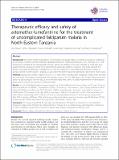| dc.description.abstract | Background: The World Health Organization recommends that regular efficacy monitoring should be undertaken
by all malaria endemic countries that have deployed artemisinin combination therapy (ACT). Although ACT is still
efficacious for treatment of uncomplicated malaria, artemisinin resistance has been reported in South East Asia
suggesting that surveillance needs to be intensified by all malaria endemic countries. This study assessed the
efficacy and safety of artemether-lumefantrine (AL) for the treatment of uncomplicated falciparum malaria in
Muheza district of north-eastern Tanzania, an area where the transmission has significantly declined in recent years.
Methods: Eighty eight children (aged 6 months to 10 years) with uncomplicated falciparum malaria were recruited
into the study. The patients were treated with standard doses of AL and followed up for 28 days. The primary end
point was parasitological cure on day 28 while the secondary end points included: improvement in haemoglobin
levels and occurrence, and severity of adverse events.
Results: A total of 163 febrile patients were screened, out of which 88 patients (56 under-fives and 32 aged ≥5 years)
were enrolled and 79 (89.8%) completed the 28 days of follow-up. There were no cases of early treatment failure
whilst 40 (78.4%) under-fives and 21(75.0%) older children had adequate clinical and parasitological response
(ACPR) before PCR correction. Late clinical failure was seen in 5.6% (n = 51) and 3.6% (n = 28) of the under-fives and
older children respectively; while 15.7% and 21.6% had late parasitological failure in the two groups respectively.
After PCR correction, ACPR was 100% in both groups. Reported adverse events included cough (49.7%), fever (20.2%),
abdominal pain (10.1%), diarrhoea (1.3%), headache (1.3%) and skin rashes (1.3%).
Conclusion: This study showed that AL was safe, well-tolerated and efficacious for treatment of uncomplicated
falciparum malaria. Since Muheza has historically been a hotspot of drug resistance (e.g. pyrimethamine, chloroquine,
and SP), surveillance needs to be continued to detect future changes in parasite sensitivity to ACT. | en_US |

